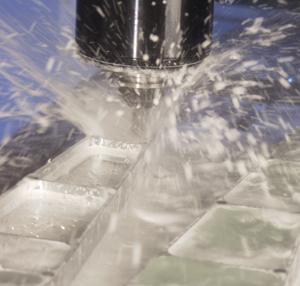- FMA
- The Fabricator
- FABTECH
- Canadian Metalworking
Choosing the Right Fluid for Difficult-to-Cut Materials
Material, application, tooling choice all affect metalworking fluid
- By Joe Thompson
- February 14, 2013
- Article
- Metalworking
Difficult-to-cut materials such as heat-resistant superalloys (HRSA) and titanium create more heat during the machining process than steel generates when it is being cut. Titanium, for example, is a poor conductor of heat, meaning the heat generated during the cutting of this metal does not dissipate as quickly.
This poor conductivity, combined with high hardness levels as measured by the Rockwell C scale (HRC), makes the cutting zone much hotter, especially at the tool/workpiece interface. To maintain dimensional stability and prolong cutting tool life, coolant volume needs to be greater in these operations than that used to machine the more common steels.
When you cut these materials, the best place for coolant to be is just before the cut, on the tool cutting edge, and on the tool's wear surface. Basically, coolant should be everywhere a part/tool interface occurs.
According to David Foster, district sales manager for Master Chemical Corp., chlorine- and sulfur-based fluids are beneficial in applications that allow their use. Good results also can be achieved with ester-based coolants, which can lengthen tool life much like chlorinated fluid does.
"However, if it's a situation in which chlorine and sulfur are restricted, a high-oil-content coolant is highly recommended," said Foster. "If that's not practical, then the concentration of the coolant should be increased to the highest recommended concentration level for the specific product."
Also, because most HRSA materials work-harden quickly, dwell time of the cutting tool must be minimized; although, no coolant strategy will correct what is actually a programming error.
"Remember, a nice small chip with a blue color is normal for most HRSA materials, and the part should never have a blue tint," said Foster.
Understanding the Materials
Superalloys typically fall into three categories: nickel-based, iron-based, and cobalt-based. When these three materials are machined, approximately 75 percent of the generated heat is removed by the chip. However, in titanium machining the opposite is true; only 25 percent of the heat is removed by the chip. This is not the only difference between these materials, though.
HRSAs
- Require lighter cuts because of their high hardness.
- Require a cutting fluid with high lubricity.
- Often cannot be cut using sulfur-based fluids.
Titanium
- Requires heavy cuts because the metal will spring back if lighter cuts are used.
- Demands a precise cooling rate.
- Often cannot be cut using chlorinated products.
Tooling Choice
Not only does the material of the tool —whether it's high-speed steel, carbide, ceramic, or cermet—change the criteria for the coolant, so does the type, design, and usage.
For example, a 3-flute tap has different coolant requirements than a 4-flute tap. The kind of cut—continuous or intermittent—also matters. For example, ceramics are highly sensitive to intermittent cuts, especially when a high volume of coolant is used.
"The more metal-to-metal contact between the part and the tool, the more lubrication is needed, with the opposite also being true," said Foster. "This means that applications such as single point turning or grinding will require a coolant with a very high cooling capacity, like that of synthetics, and applications such as drilling and reaming require very high lubrication."
A machine shop will typically choose the coolant that solves its most difficult problems and compromise on the others. Ordering a metalworking fluid specifically made for these applications is recommended over picking up a few pails while ordering other supplies, added Foster.
Pressure Versus Volume
Higher-pressure coolant delivery to the work zone helps to break chips, but it's coolant volume that moves them. Volume in milling operations, for example, should be about 1 GPM for every 1.5 HP.
"Pressure helps to break the chip and therefore is very dependent on tool choice and material," said Foster. In a drilling application, high-pressure, through-the-tool coolant delivery is recommended. It's also preferred to have the volume of the hole in coolant delivery per every revolution. Again, volume moves chips."
Long, stringy chips should not appear in high-work-hardening materials such as these and are not normal.
Recycling and Disposal
While coolant used for difficult cutting applications can be recycled, the coolant used for high-nickel and high-cobalt-alloy machining requires special handling. Some operators may have sensitivity to nickel and cobalt, so care should be taken during this process.
Coolant can be recycled using a simple coalescer or a complete in-plant system with a high-speed disk bowl centrifuge, depending on the shop's needs.
Workers who handle coolant for recycling always should wear the personal protective equipment the coolant manufacturer recommends and as specified in the material safety data sheet (MSDS), Foster said.
Recycling depends on the coolant, he added, and all necessary local and provincial safety regulations for disposal need to be followed.
"There is no one-size-fits-all theory for coolant," said Foster, "but remember, the better the coolant and coolant management system, the longer the coolant will last in the sump and overall costs will be reduced."
subscribe now


Keep up to date with the latest news, events, and technology for all things metal from our pair of monthly magazines written specifically for Canadian manufacturers!
Start Your Free Subscription- Trending Articles
- Industry Events
CTMA Economic Uncertainty: Helping You Navigate Kitchener Seminar
- May 2, 2024
- Kitchener, ON Canada
Automate 2024
- May 6 - 9, 2024
- Chicago, IL
ANCA Open House
- May 7 - 8, 2024
- Wixom, MI
17th annual Joint Open House
- May 8 - 9, 2024
- Oakville and Mississauga, ON Canada
MME Saskatoon
- May 28, 2024
- Saskatoon, SK Canada















